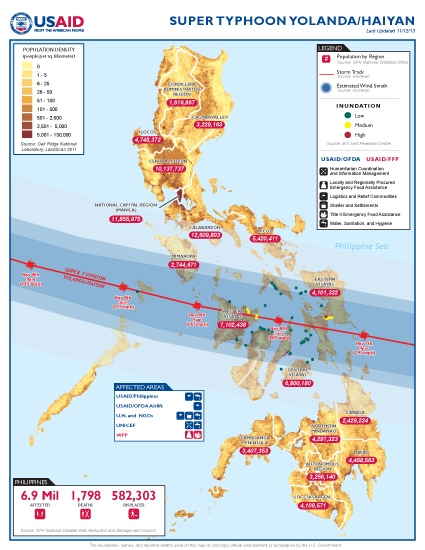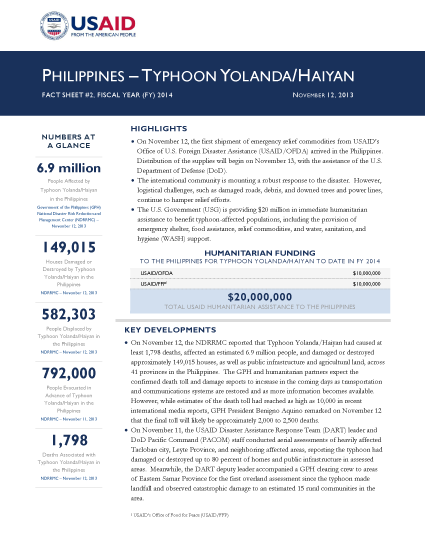- What We Do
- Agriculture and Food Security
- Democracy, Human Rights and Governance
- Economic Growth and Trade
- Education
- Ending Extreme Poverty
- Environment and Global Climate Change
- Gender Equality and Women's Empowerment
- Global Health
- Water and Sanitation
- Working in Crises and Conflict
- Disaster Assistance
- Political Transition Initiatives
- Conflict Mitigation and Prevention
- Countering Violent Extremism
- Disaster Risk Reduction
- Peacebuilding and Reconciliation
- Providing Safe & Secure Environments for Development
- Recovering From Crisis
- Resilience
- Tech Challenge for Atrocity Prevention
- World Humanitarian Day
- U.S. Global Development Lab
November 12, 2013
Numbers At A Glance
6.9 million
149,015
582,303
792,000
1,798
Humanitarian Funding:
To The Philippines For Typhoon Haiyan/Yolanda To Date In FY2014:
| USAID/OFDA | $10,000,000 |
| USAID/FFP | $10,000,000 |
| TOTAL | $20,000,000 |
Typhoon Haiyan / Yolanda Fact Sheet #2 - 11/12/2013 ![]() (pdf - 185k)
(pdf - 185k)
Highlights
On November 12, the first shipment of emergency relief commodities from USAID’s Office of U.S. Foreign Disaster Assistance (USAID/OFDA) arrived in the Philippines. Distribution of the supplies will begin on November 13, with the assistance of the U.S. Department of Defense (DoD).
The international community is mounting a robust response to the disaster. However, logistical challenges, such as damaged roads, debris, and downed trees and power lines, continue to hamper relief efforts.
The U.S. Government (USG) is providing $20 million in immediate humanitarian assistance to benefit typhoon-affected populations, including the provision of emergency shelter, food assistance, relief commodities, and water, sanitation, and hygiene (WASH) support.
Key Developments
On November 12, the NDRRMC reported that Typhoon Yolanda/Haiyan had caused at least 1,798 deaths, affected an estimated 6.9 million people, and damaged or destroyed approximately 149,015 houses, as well as public infrastructure and agricultural land, across 41 provinces in the Philippines. The GPH and humanitarian partners expect the confirmed death toll and damage reports to increase in the coming days as transportation and communications systems are restored and as more information becomes available. However, while estimates of the death toll had reached as high as 10,000 in recent international media reports, GPH President Benigno Aquino remarked on November 12 that the final toll will likely be approximately 2,000 to 2,500 deaths.
On November 11, the USAID Disaster Assistance Response Team (DART) leader and DoD Pacific Command (PACOM) staff conducted aerial assessments of heavily affected Tacloban city, Leyte Province, and neighboring affected areas, reporting the typhoon had damaged or destroyed up to 80 percent of homes and public infrastructure in assessed areas. Meanwhile, the DART deputy leader accompanied a GPH clearing crew to areas of Eastern Samar Province for the first overland assessment since the typhoon made landfall and observed catastrophic damage to an estimated 15 rural communities in the area.
CURRENT SITUATION
- On November 11, GPH authorities declared a state of national calamity due to the effects of the typhoon. International media report widespread looting in Tacloban, and the Armed Forces of the Philippines (AFP) deployed an additional 500 to 800 soldiers to the city to augment local authorities’ security operations and deter unrest. Soldiers killed two armed insurgents during an attack on an aid convoy en route to Tacloban city on November 12. The GPH has also deployed armored vehicles, established checkpoints, and imposed a curfew to help restore law and order as relief operations ramp up in the city.
- Although international assistance has begun to arrive in the Philippines, logistical challenges, such as damaged roads, debris, and downed trees and power lines, are hampering relief efforts and impeding life-saving assistance from reaching populations in need. A lack of electricity in Tacloban has made landing planes carrying relief commodities impossible at night, according to international media.
U.S. GOVERNMENT (USG) RESPONSE
- The first USAID/OFDA shipment of emergency relief commodities—comprising 10,080 hygiene kits and 1,000 rolls of plastic sheeting—arrived in Manila and cleared customs on November 12. USAID/OFDA logistics staff are coordinating the transport of supplies from the warehouse to the AFP air base, where the commodities will be loaded onto U.S. military airplanes. DoD is scheduled to transport the hygiene kits and plastic sheeting to Tacloban on November 13 for onward distribution by humanitarian partners on the ground. A second identical USAID/OFDAprocured shipment is tentatively scheduled to arrive in Manila on November 14.
- On November 11, USAID/OFDA committed $750,000 to the U.N. Children’s Fund (UNICEF) to support WASH cluster coordination and direct support for typhoon-affected populations, particularly women and children.
- DoD continues to work in cooperation with GPH officials to provide immediate disaster relief. PACOM has transported a number of personnel working on emergency relief efforts to Tacloban via military aircraft, including staff from the GPH Department of Social Welfare and Development, the U.N. World Food Program (WFP), and members of the Emergency Telecommunications (ETC) Cluster—the coordinating body for ETC activities in the Philippines.
- A USAID/FFP airlift carrying 55 metric tons (MT) of emergency food products from Miami, Florida—capable of feeding 20,000 children under five years of age and 15,000 adults for five days—is due to arrive in Cebu Province on November 13. The food will be distributed by WFP and will target vulnerable populations in most-affected communities.
- The DART continues to conduct initial damage assessments in affected areas of the Philippines and has established an Emergency Operations Center at USAID/Philippines, located at the U.S. Embassy in Manila. The DART is liaising with other humanitarian and government actors in the country and will recommend appropriate response options based on assessment findings, while the Washington, D.C.-based Response Management Team (RMT) is coordinating the USG humanitarian response, programing relief activities, and providing support to the DART. Additional USAID/OFDA staff in Bangkok, Thailand; Honolulu, Hawaii; and Washington, D.C., remain in frequent contact with the DART and humanitarian partners to monitor humanitarian conditions and coordinate relief efforts.
OTHER HUMANITARIAN ASSISTANCE
- Despite logistical challenges, the international community is rushing to provide life-saving assistance to people in need in the Philippines. On November 10, Japan deployed a 25-member medical team to the Philippines to provide assistance in the wake of the typhoon. On November 11, Canada sent a team of 200 people to assess humanitarian needs and assist with the disaster response, according to a government official. The Government of Norway has announced $3.3 million in humanitarian assistance for the Philippines, while the United Arab Emirates (UAE) has pledged $10 million in aid and development programs. The U.K. increased its funding for the typhoon response to nearly $16 million. Additionally, several European countries, including Sweden, Belgium, France, Germany, and the U.K., are providing assistance in the form of shelter kits, water purification units, and communications equipment.
- WFP is transporting 44 MT of high energy biscuits to Manila for subsequent airlift to Tacloban city. WFP is also deploying mobile storage units, pre-fabricated offices, and generators from the U.N. Humanitarian Response Depot in Malaysia to allow aid workers to establish operational hubs at the Tacloban and Cebu airports. In addition, WFP information technology equipment, including digital radios, is en route from Dubai, UAE.
- On November 12, the International Federation of Red Cross and Red Crescent Societies released an emergency appeal for nearly $79 million, requesting cash, in-kind donations, and services to meet the needs of 100,000 families—or 500,000 people—for 18 months. Funding will support the distribution of emergency food assistance and increase access to safe drinking water and shelter.
- Also on November 12, the U.N. released a Humanitarian Action Plan for Typhoon Yolanda/Haiyan, requesting $301 million for the response, including approximately $76 million for food assistance, $46 million for shelter, $31 million for livelihoods, $22 million for WASH activities, and $21.5 million for health.









Comment
Make a general inquiry or suggest an improvement.